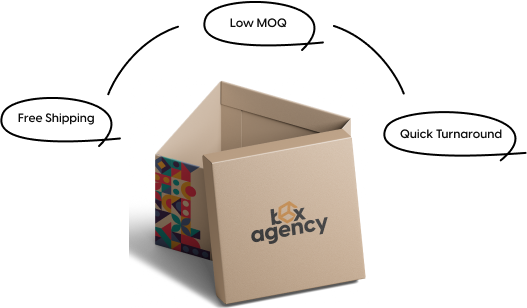Embossing and Debossing Guide: Process, Difference and Benefits
In today’s competitive market, creative packaging is a powerful tool for brand recognition. Unique packaging designs grab the customer’s attention and make a lasting impression on potential buyers even before its opening. The eye-catching packaging conveys a sense of premium quality and exclusivity. Embossing and Debossing create visually appealing product packaging to make an impact on the target market. The three-dimensional outlook aligns with the brand’s aesthetics by incorporating attractive textures and patterns. To understand the techniques more, let’s have a look at the article below:
What is Embossing?
Embossing is a finishing technique that creates an elevated pattern on the surface of the packaging material to achieve the desired design. The dieline template is pressed beneath the material to make the packaging visually attractive for potential buyers.
What is Debossing?
Debossing is the opposite of embossing. It creates a recessed pattern on the surface of product packaging to achieve the desired outlook. In debossing, the dieline template is pressed onto the material to make the packaging appealing and interesting to target customers.
What is the Process of Embossing?
The process of embossing breaks down into the following general steps:
- Create the required digital design or pattern.
- Craft a dieline template of the design with the raised elements.
- The material is placed on a flat surface for embossing.
- Apply pressure on the dieline template to force the design onto the material.
- The embossed design creates an elevated design or pattern on the surface of the chosen material.
What is the Process of Debossing?
The process of debossing breaks down into the following general steps:
- Create the required digital design or pattern.
- Craft a dieline template of the design with the recessed elements.
- The material is placed on a flat surface for debossing.
- Apply pressure on the dieline template to force the design onto the material.
- The debossed design creates a depressed design or pattern on the surface of the chosen material.
What is the Difference Between Embossing & Debossing?
The difference between embossing and debossing is shown in the table below:
|
Feature |
Embossing |
Debossing |
|
Style |
The design elements make the packaging visually appealing with elevated text, logos, or decorative patterns. |
The design elements are pressed into the material to create a subtle and understated effect. |
|
Heat Utilization |
Heat plays an important role in shaping the material into the desired design. |
Pressure is more important than heat when creating the required design. |
|
Need of Die |
Create a raised design by pushing the material upwards. |
Create a depressed design by pushing the material downwards. |
|
The ideal materials are kraft paper and cardboard. |
The ideal materials are kraft paper and cardboard. |
What are the Benefits of Embossing & Debossing?
The following are the benefits of embossing & debossing:
Increase Product Value
Embossing and debossing increase the product’s perceived value with its premium outlook. The luxurious and sophisticated packaging makes the product stand out on retail store shelves. They highlight important information, including brand logos, product names, or key ingredients.
Aesthetic Feel
Embossing and debossing give depth and dimension to the design. It enhances the overall brand image and targets customer preferences. The technique makes the material visually appealing and adds tactile experiences to draw the customer’s attention.
Brand Recognition
Embossing and debossing are mostly associated with high-end products to convey a sense of luxury and quality. The 3D effect makes the design visually appealing and efficiently communicates the brand values. This builds strong brand recognition and creates a lasting impression on the target customers.
Focus on Significant Aspects
Embossing and debossing make logos, product names, or product details the center of attention. This enhances customer engagement and keeps the buyers hooked with the interactive design. These techniques add depth and dimensions to the intricate design, complementing the brand’s reputation.
What are the Embossed and Debossed Paper Styles?
Embossing and debossing make the designs visually appealing, interactive, and interesting. To understand it more, the following are different embossed and debossed paper styles:
Blind Embossing
Blind embossing creates an elevated design or pattern without the use of ink. The playfulness of light and shadow makes the design visible to potential buyers. The dieline template is pressed onto the material to craft a 3D effect of this type. This is mostly used for book covers, stationery, and packaging.
Registered Embossing
In registered embossing, the embossed design precisely aligns with another element, such as ink or foil. The embossing dieline template design matches the printing plate to ensure the perfection of the elevated design. This technique is commonly used for invitations and product packaging to add visual interest to printed materials.
Combination Embossing
Combination embossing is the technique of combining embossing with some other finishing techniques to create visually appealing packaging designs. The process involves the embossing of the design followed by the application of metallic or colored foils to the elevated areas. This gives high-end packaging a luxurious outlook and makes the products stand out on retail store shelves.
What are the Common Applications of Embossing & Debossing?
Embossing & debossing are widely used in various applications to make product packaging attractive with a touch of elegance and style. They convey a sense of exclusivity and quality to enhance brand recognition. Following is the list of common applications of embossing & debossing:
- Brochures
- Postcards
- Business cards
- Letterheads
- Certificates
- Folders
- Packaging
Why Use Embossing & Debossing?
Embossing & debossing are used to make the packaging visually interesting and increase customer engagement. These techniques play an imperative role in drawing the buyer’s attention to logos, brand names, and other details. They also enhance the durability of high end packaging and allow customers to interact with the design, creating a memorable unboxing experience.
Can We Use Embossing & Debossing on Shipping Boxes?
Embossing & Debossing can be used on shipping boxes but the complexity of design can become limited due to the thickness and rigidity of packaging materials. Shipping boxes going for embossing or debossing are mostly simple to make the brands enjoy cost-effectiveness. Intricate designs increase the production cost and risk the durability of the shipping boxes.
Where To Get Embossed & Debossed Packaging Boxes?
Embossed & Debossed packaging boxes are not readily available for use. Therefore, the brands should contact a reliable packaging supplier for embossed or debossed packaging boxes. Box Agency is a leading packaging manufacturer operating to give clients the required product packaging at competitive prices. We are a hub of professionals working tirelessly to give your packaging an exquisite outlook. Our embossed or debossed packaging box designs are impressive and keep the customers hooked with your brand to augment the sales volume. So, place your order and enjoy being the best in town.




